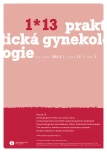Behavioral determinants of osteoporosis: should we educate women about osteoporosis?
Authors:
Blanka Trojanová
Authors‘ workplace:
Katedra porodní asistence, LF MU, Brno, vedoucí katedry doc. MUDr. Igor Crha, CSc.
Published in:
Prakt Gyn 2013; 17(1): 86-92
Category:
Nursing in Gynaecology: Original Article
Overview
Objective:
Objective of this study was to verify the educational needs of women in the prevention of osteoporosis based on the occurrence of modifiable risk factors for disease, determine the occurrence of the behavioral risk factors among women in various age groups and their impact on their health.
Material and methods:
An examination was carried out on 737 women in the city of Brno. Through the distributed questionnaire CINDI Health Monitor. The examined women were stratified according to their age as follows: group A (16–24 years), group B (25–49 years), group C (50–65 years). The study focussed on the incidence of high-risk behavior in the categories of tobacco smoking, inadequate nutrition, excessive alcohol consumption, low physical activity and extreme values of BMI. The results were compared between defined groups of women. For a statistical significance was used test ANOVA (post hoc test) and Fishers Exact Test.
Results:
The examination showed highly significant differences in the incidence of tobacco smoking – the most active smoking group was A (p < 0.05), poor eating habits were most pronounced in groups A (ANOVA test < 0.05), excessive alcohol consumption was highest at group A (p < 0.05), the risk factor for the lack of physical activity was generally significant (p < 0.05) as age increased. The evaluation of the health impact of smoking was only in group A (p < 0.05), inadequate food had an effect on group B (p < 0.05), excessive alcohol consumption had no effect on any group (A (p > 0.05). Physical activity had an effect on all groups (p < 0.05), BMI only had an effect in group C (p < 0.05).
Conclusion:
These recent results show that risk factors are most common in group A, while these women do not consider the risks to their health. The need to educate young women in the prevention of osteoporosis appears to be necessary.
Key words:
osteoporosis – non-pharmacological prevention – behavioral determinants – educational needs
Sources
1. Vyskočil V. Osteoporóza a ostatní nejčastější metabolická onemocnění skeletu. Galén: Praha 2009.
2. Růžičková O. FRAX – predikce individuálního rizika zlomenin, výhody a limitace. Klimakter Med 2010; 15(4): 6–10.
3. Ferrari S. Human genetisc of osteoporosis. Clin Endocr Metab 2008; 22(5): 723–735.
4. Fait T, Koudová M. Genetická predikce osteoporózy v klinické praxi. Prakt Gyn 2011; 15(3–4): 144–148.
5. Broulík P, Kazda A. Výživa a její vztah ke kostnímu metabolismu. Inter Med 2009; 11(3):111–114.
6. Hrubá D, Fiala J, Nebeská K, Soška V. Ženy obtížněji zanechávají kouření: je to vlivem pohlavních hormonů? Hyg 2010; 55(1): 25–27.
7. Fraňková S, Dvořáková-Janů V. Psychologie výživy a sociální aspekty jídla. Karolinum: Praha 2003.
8. Benetou V et al. Diet and hip fractures among elderly Europeans in the EPIC cohort. Europ J Clin Nutrit 2011; 65(1): 132–139.
9. Mahan K, Escot-Stump K. Krause’s food & nutrition therapy. 12th ed. Saunders/Elsevier: St. Louis 2008.
10. Fojtík P, Urban O. Falt P, Novosad P. Výživa a sekundární osteoporóza. Inter Med 2009; 11(12): 561–568.
11. Sizer FS, Whitney E. Nutrition Concepts and Controversies. 9th ed. Wadsworth: Belmont 2003.
12. Piťha J, Poledne R. Zdravá výživa pro každý den. Grada Publishing: Praha 2009.
13. Dungl P. Ortopedie. Grada Publishing: Praha 2005.
14. Yoo H, Park M, Yang S at al. The differential relationship between fat mass and bone mineral density by gender and menopausal status. J Bone Miner Metab 2012; 30(1): 47–53.
15. CINDI HEALTH MONITOR 2002 – Zdravotní chování populace ČR ve věku 25–64 let [online]. Dostupné z WWW: <http://www.szu.cz/czzp/cindi/index>.
16. Elmadfa I (ed). European nutrition and health report 2009. Karger: Basel 2009.
17. Soha E, Heba E, Helmy A et al. Serum leptin concentration, bone mineral denzity and bone biochemical markers in a sample of Egyptian women: A possible relationship. Egypt Rheumatol 2011; 33(4): 171–177.
18. Anderson K, Chad K, Spink S. Osteoporosis knowledge, beliefs, and practices among adolescent females. J Adolesc Heal 2005; 36(4): 305–312.
Labels
Paediatric gynaecology Gynaecology and obstetrics Reproduction medicineArticle was published in
Practical Gynecology

2013 Issue 1
Most read in this issue
- Influence of some anesthetics and sedatives on source of sexual hallucination: undervalued forensic risk for doctors
- Problems of large birth trauma and associated complications
- Rare complications associated with uterine myomatosis: case reports
- Indications of mammography, breast ultrasound and breast magnetic resonance imaging in young women
